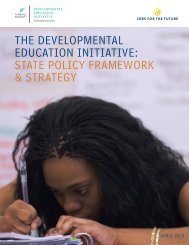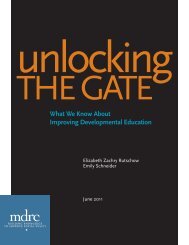Preparing High School Students for College - ERIC - U.S. ...
Preparing High School Students for College - ERIC - U.S. ...
Preparing High School Students for College - ERIC - U.S. ...
- No tags were found...
Create successful ePaper yourself
Turn your PDF publications into a flip-book with our unique Google optimized e-Paper software.
Student Recruitment and ParticipationBarriers to student participation range from competing priorities (e.g., after-schoolor summer jobs; athletic team practices) to costs (e.g., fees <strong>for</strong> participation) to logistics(e.g., transportation to summer bridge programs). Institutions offering these programs mayincrease their success at recruiting and retaining participants by addressing logisticalchallenges to participation. For example, at multiple programs we visited, the high schooland college partners found ways to split responsibilities <strong>for</strong> funding and facilitatinglogistics, such as transportation and meals <strong>for</strong> students. Student participation may also beencouraged with financial incentives (e.g., stipends or jobs) or nonfinancial incentives (e.g.,college credit or the opportunity to place out of developmental education). An alternative isto make program participation mandatory.SustainabilityIn some cases, college readiness programs are available in some years and not inothers, or they may only last <strong>for</strong> a few years. In the ongoing ef<strong>for</strong>t to build effective collegereadiness programs, funding challenges will need to be addressed. Time-limited funds, suchas grants, are often best used to support start-up costs <strong>for</strong> specific programs or programcomponents. Often these start-up costs are higher than the steady-state costs that follow,and short-term grant funding can help to establish a program. However, in order to createsustainable programs, institutions must identify ongoing resources.Implications <strong>for</strong> <strong>College</strong> Readiness PartnershipsDeepening Partnerships <strong>for</strong> Greater Influence<strong>College</strong> readiness programs depend upon the relationships between K-12 schooldistricts — particularly at the secondary level — and local colleges. <strong>High</strong> schools andcolleges observed in our site visits demonstrated that they could execute short-term, discreteprograms. In some cases, their relationships led to more substantive initiatives. We wouldsuggest that increasingly substantive partnerships should be fostered because they maypromote cost efficiencies, long-term program sustainability, and systemic changes, such asthe improved alignment of curriculum and assessment practices.Testing the Potential Cost Savings Produced by PartnershipsTraditionally, K-12 systems and higher education are separate entities that mayoffer similar services in the same community. Eliminating redundant services and aligningremaining services may reduce the resources required to support college readiness31





